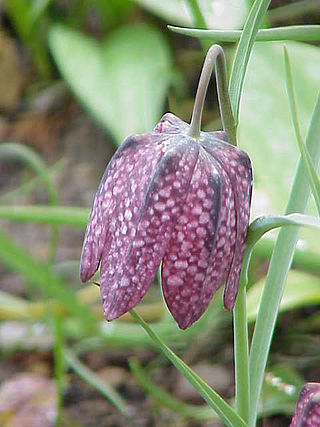
Fritillaria (fritillaries) is a genus of spring flowering herbaceous bulbous perennial plants in the lily family (Liliaceae). The type species, Fritillaria meleagris, was first described in Europe in 1571, while other species from the Middle East and Asia were also introduced to Europe at that time. The genus has about 130–140 species divided among eight subgenera. The flowers are usually solitary, nodding and bell-shaped with bulbs that have fleshy scales, resembling those of lilies. They are known for their large genome size and genetically are very closely related to lilies. They are native to the temperate regions of the Northern hemisphere, from the Mediterranean and North Africa through Eurasia and southwest Asia to western North America. Many are endangered due to enthusiastic picking.

The lily family, Liliaceae, consists of about 15 genera and 610 species of flowering plants within the order Liliales. They are monocotyledonous, perennial, herbaceous, often bulbous geophytes. Plants in this family have evolved with a fair amount of morphological diversity despite genetic similarity. Common characteristics include large flowers with parts arranged in threes: with six colored or patterned petaloid tepals arranged in two whorls, six stamens and a superior ovary. The leaves are linear in shape, with their veins usually arranged parallel to the edges, single and arranged alternating on the stem, or in a rosette at the base. Most species are grown from bulbs, although some have rhizomes. First described in 1789, the lily family became a paraphyletic "catch-all" (wastebasket) group of lilioid monocots that did not fit into other families and included a great number of genera now included in other families and in some cases in other orders. Consequently, many sources and descriptions labelled "Liliaceae" deal with the broader sense of the family.

Nomocharis is a genus of flowering plants in the family Liliaceae. It consists of about 7 species native to montane regions of western China, Myanmar, and northern India. They are similar to Lilium, with one of the more obvious differences being the flowers being more shallow or sometimes flat.

Fritillaria uva-vulpis, commonly called the fox's grape fritillary, is a bulbous perennial plant belonging to the genus Fritillaria and native to eastern Turkey, north-western Iraq and western Iran. They are mainly found in the wooded foothills of the Zagros, where they grow in damp meadows and cornfields between 900 and 1800 m above sea level.
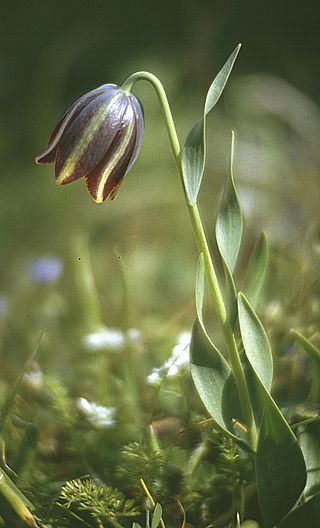
Fritillaria graeca is a European plant species in the lily family Liliaceae. It is native to the Balkans. Some older literature says that the plant can also be found in Serbia, but all these collections are of var. gussichiae, now regarded as a distinct species called Fritillaria gussichiae.

Notholirion is a small Asian genus of bulbous plants in the lily family, Liliaceae. It is closely related to Lilium, but each individual flowers only once, and then dies after producing offsets. The bulb is covered by a tunic. Leaves are basal, produced in autumn and winter.
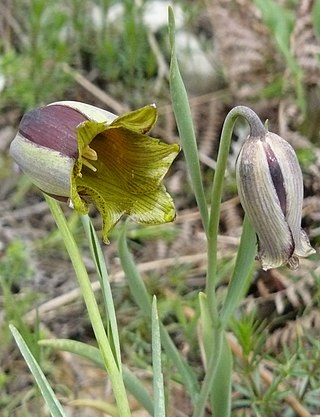
Fritillaria acmopetala, the pointed-petal fritillary, is a species of flowering plant in the lily family Liliaceae, native to rocky limestone mountain slopes in the Middle East. It was described by the Swiss botanist Pierre Edmond Boissier in 1846.

Barnardia is a small genus of bulbous flowering plants in the family Asparagaceae, subfamily Scilloideae. The genus has two species, one found in the Balearic Islands and north-west Africa, the other in east China, Korea, Japan and adjacent localities. It was suggested in 2012 that the two species were not closely related.

Fritillaria crassifolia is a Middle Eastern species of bulb-forming flowering plant in the lily family Liliaceae, native to Iran, Iraq, Turkey, Syria, and Lebanon.

Fritillaria gibbosa is a species of herbaceous perennial plant in the lily family Liliaceae. It is native to Afghanistan, Iran, Pakistan, Turkmenistan, and Transcaucasia.
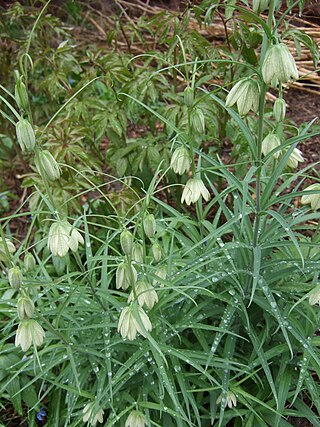
Fritillaria thunbergii is a flowering plant species in the lily family Liliaceae. It is native to Kazakhstan and in Xinjiang Province of western China, though cultivated in other places and naturalized in Japan and in other parts of China.
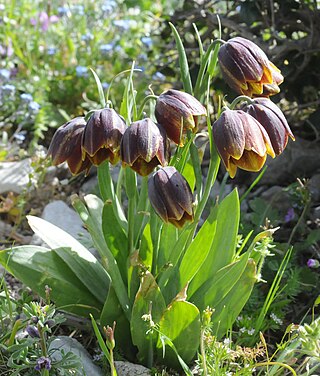
Fritillaria rhodocanakis is a species of plant in the lily family Liliaceae. In its pure form, it is found only on Hydra Island and on small neighboring islands in Greece. Additional populations occur in the Peloponnisos region of mainland Greece, though the specimens there show some degree of hybridization with F. spetsiotica and F. graeca. In 1987, some of the hybrids were described with the name Fritillaria rhodocanakis subsp. argolica, but this is now generally referred to as Fritillaria × spetsiotica Kamari.
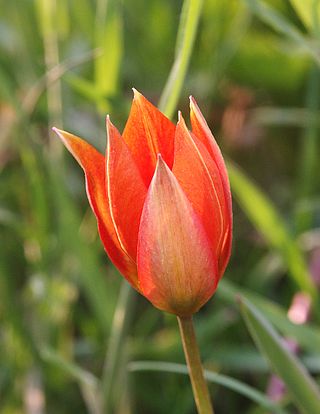
Tulipa orphanidea is a species of flowering plant in the Liliaceae family. It was described by Pierre Edmond Boissier and Theodor Heinrich Hermann von Heldreich (1862).
Edward Martyn Rix is a British botanist, collector, horticulturist and author. Following completion of a PhD on Fritillaria at Cambridge University, he worked in Zürich, Switzerland and at the Royal Horticultural Society gardens at Wisley. He is the author of many books and articles on plants and horticulture and is the editor of Curtis's Botanical Magazine, based at the Royal Botanic Gardens, Kew in London.

Fritillaria assyriaca is a bulbous herbaceous perennial plant occurring in a region stretching from Turkey to Iran. It is a species in the genus Fritillaria, in the lily family Liliaceae. It is placed in the subgenus Fritillaria.

Fritillaria raddeana is a perennial herbaceous bulbous plant, distributed in Iran, Turkmenistan and Kashmir. It is a species in the genus Fritillaria, in the lily family Liliaceae. It is placed in the subgenus Petilium. Resembling Fritillaria imperialis, but shorter, it is sometimes referred to as the dwarf crown imperial.
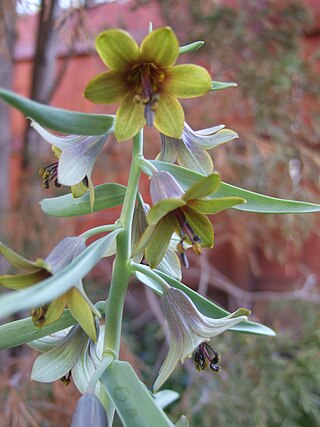
Fritillaria sewerzowii is a perennial herbaceous bulbous plant, distributed in alpine areas of central Asia. It is a species in the genus Fritillaria, in the lily family Liliaceae. It is placed in the subgenus Korolkowia.

Fritillaria dagana is a rare bulbous herbaceous perennial plant native to Siberia, Russia. It is a species in the genus Fritillaria of the family Liliaceae. It is placed in the subgenus Liliorhiza.

Fritillaria reuteri is a perennial herbaceous bulbous plant, distributed in Turkey and Iran. It is a species in the genus Fritillaria, in the family Liliaceae. It is placed in the subgenus Fritillaria.


















